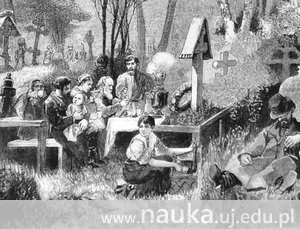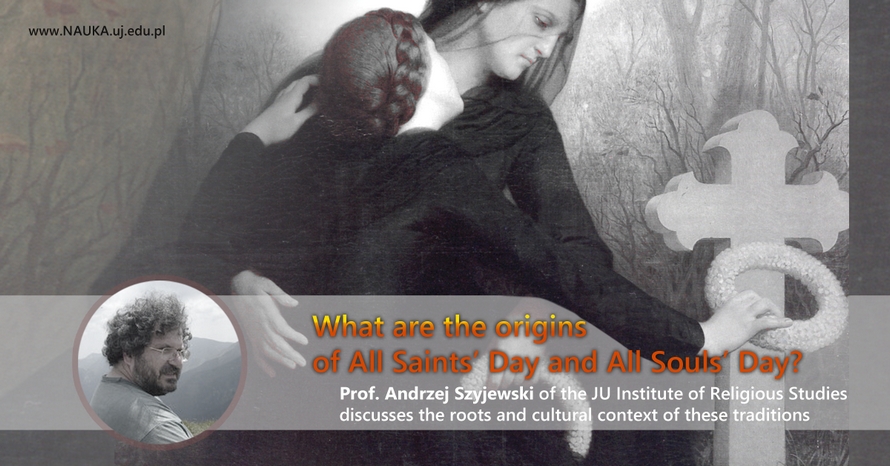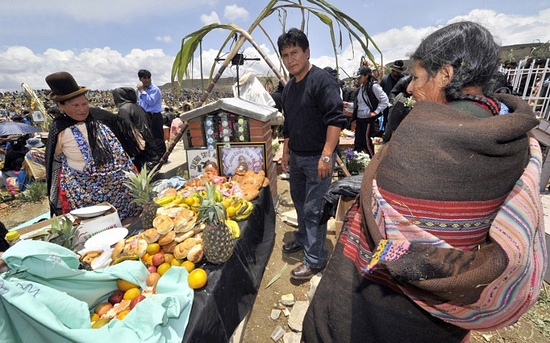
November begins with holidays deeply rooted in the Polish tradition. Recently, they have also been joined by Halloween, whose character is completely different. What are the origins of these customs? How did they use to be celebrated in the past? We asked these questions to Prof. Andrzej Szyjewski from the JU Institute of Religious Studies.
-----------------------------------------
1Question is a series of articles by the University Marketing science communication unit, in which specialists and experts from various fields briefly discuss interesting issues related to the world, civilisation, culture, biology, history, and many more.
-----------------------------------------
All Saints’ Day was established in the early 6th century A.D. by Pope Boniface IV. Initially, it was celebrated on 13 May. In 731 Pope Gregory III moved the feast to 1 November, aiming to replace the most important pagan festival of the dead. All Souls’ Day of November 2 was established by the Church as late as 988, during the pontificate of Sylvester II. The celebrations to mark these days differ from culture to culture and from region to region. What is common for different traditions is the conviction that the world of the dead and the world of the living to some extent interpenetrate each other, instead of being two independent realities. Hence, those who passed away can appear among the living.

The Slavic people found ties of kinship very important, which was reflected in the willingness to spent time together, especially during festivals and celebrations. There were even special periods when the dead came to the world of the living to celebrate together. Most probably, there were four such feasts, the time of which was related to the changing of the seasons. One of them, which survived as the All Souls’ Day was celebrated at the time when all work in the fields was over and people prepared for winter. Thus, the day should be interpreted as a symbolic passage to the world of death. Other festivals of the dead also became part of the main Christian holidays. Nowadays, people still visit cemeteries during Easter and Christmas.
The name Dziady originated from one of the words denoting spirits of ancestors. In late October/early November Slavs held this feast to commemorate the dead, especially those who passed away relatively recently. As illustrated by the Romantic poet Adam Mickiewicz in his famous work Dziady, the celebrations were collective in character. It was a family festival, the central part of which was a feast, during which the living dined together with the dead. Souls of the dead wanted the living to provide them with food, water and a place to warm up. The food for the dead needed special preparation, as they accepted only certain types of victuals, for instance grains, which may be related to the image of the soul as a bird. When grain was left on graves, birds that ate it were identified with hungry souls. Besides, a special type of bread, known as “god’s bones” or “bones of the dead” was baked specially for the dead, and then left on graves or given to the poor. The spirits were also fed with honey (probably because of its preservative properties), nuts and – especially among Eastern Slavs – with pierogi dumplings.

All Souls’ Day in Bolivia, source: Diariocritico de Venezuela/Flickr, licence CC BY-SA
Similar festivals used to be celebrated by Celts. One of them is Halloween, which took hold in the English-speaking culture and then spread to other parts of the world. The Celtic festivals of the dead were very spectacular in terms of the performed rituals. They marked the opening of the gates through which the dead could access the world of the living, and vice-versa.
In many cultures, including the Slavonic, fire was a very important element of the worship of the dead. When visiting homes, the souls wanted to warm themselves up, so it was necessary to light the stove. At the cemetery, there was also a place for the dead to get warm. Initially, bonfires were lit for them. Later, they were replaced by candles, oil lamps, and, finally, grave lanterns. The fire was also aimed at showing souls the way, especially in the case of people who died in unusual circumstances and their funeral rituals were not performed correctly. Such souls had to be treated with special care, as they existed between the world of the dead and the world of living, which made them dangerous. The role of the light of bonfires, and then candles or lanterns, was to steer them to the world of the dead.
There were also numerous rules related to All Souls’ Night. Locking the house door was prohibited, and the windows had to be left open, so that souls of the dead could get inside. It was also forbidden to get up early, in order not to disturb the spirits.
It is also worth pointing out that not only the dead could visit the world of the living, but also, under special circumstances, the living could access the world of the dead. A person who wanted to do this had to spend All Souls’ Night at the cemetery, burning an oil lamp assembled from what remained of candles lit on the graves. Only then could the person meet the spirits, talk to them, and even pay a visit to their world.
-----------------------------------------
Uncaptioned illustrations (from top):
- Smolensk Cemetery by unknown author, 1881
- part of The Day of the Dead by William Adolphe Bouguereau,1859
--------------------------------------------------
The text is a translation of the article from the website www.nauka.uj.edu.pl





